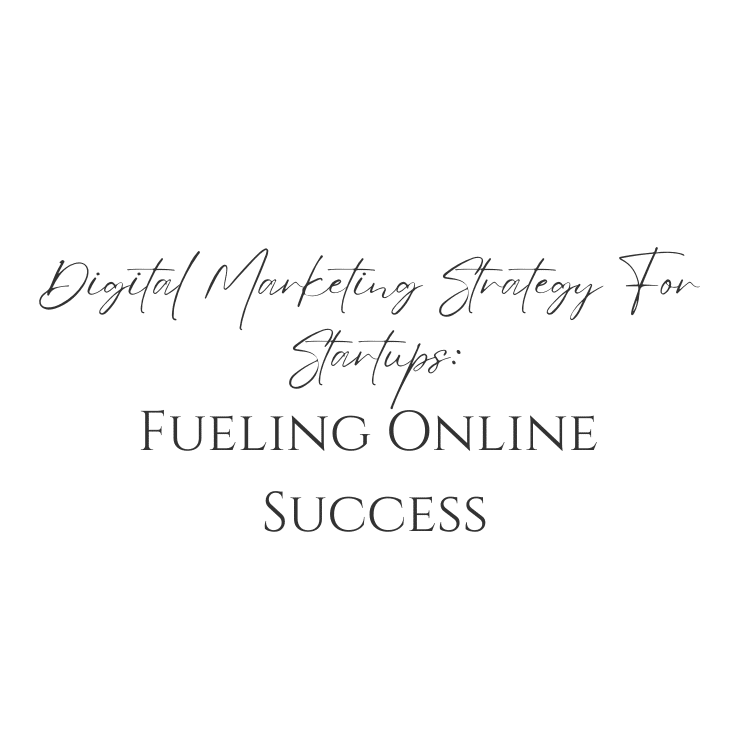You’ve heard it before: the vast majority of startups fail within the first few years. But why is that? Is it simply a matter of bad luck or poor timing? While those factors certainly play a role, there’s another crucial element that can make all the difference: digital marketing strategy.

It’s no secret that the modern business landscape is overwhelmingly online. From social media to search engines, customers are increasingly turning to the internet to find products and services. For startups looking to succeed in this environment, a solid digital marketing strategy is essential.
In this article, we’ll explore the key steps you need to take to develop an effective plan for fueling your online success. By following these guidelines and staying up-to-date with best practices, you can increase your chances of thriving in today’s competitive market.
Key Takeaways
- Conduct market research to uncover important psychographic information about the target audience.
- Create a unique value proposition to set the startup apart from competitors in the digital space.
- Choose the right digital channels to effectively reach the target audience.
- Continuously test and optimize the digital marketing campaign based on what works best for the business and target audience.
Understand Your Target Audience
Do you know who your target audience is and what they want? Understanding them is crucial to fueling your online success!

To truly understand your target audience, you need to go beyond demographics and delve into their psychographics. Psychographics provide insights into the values, beliefs, interests, and lifestyles of your potential customers. By understanding these factors, you can tailor your marketing messages to resonate with them on a deeper level.
Conducting market research is key to uncovering important psychographic information about your target audience. This can be done through surveys, focus groups, or even social media listening tools. By gathering data on their behaviors and preferences, you can create more targeted campaigns that appeal directly to their desires and needs.
By taking the time to understand your target audience’s psychographics and preferences through market research, you’ll be able to define a unique value proposition that sets you apart from competitors in the digital space. Your value proposition should clearly communicate why customers should choose your product or service over others in the market.
With this knowledge in hand, you’ll be better equipped to develop an effective digital marketing strategy that resonates with your ideal customer base.
Define Your Unique Value Proposition
Crafting your unique value proposition is like creating a shining beacon that attracts potential customers to your brand. Essentially, it’s the message you want to convey about what sets your startup apart from competitors.

It’s crucial to have a clear understanding of what makes you unique and valuable as a business before attempting to market yourself online. To craft messaging that resonates with your audience, start by identifying what problem or pain point your product or service solves. What benefits do you offer that no one else can? Be specific and make sure your language speaks directly to the needs of your target market.
Competitive differentiation is key in standing out in today’s crowded online marketplace. Once you’ve defined your unique value proposition, use it as a foundation for all of your marketing efforts. Your messaging should be consistent across all channels, from social media posts to email campaigns and website copy.
By staying true to what sets you apart, you’ll attract the right customers and set yourself up for success online. Now it’s time to set measurable goals that align with this unique value proposition and help drive growth for your startup.
Set Measurable Goals for Developing a Digital Marketing Strategy For Startups.
When setting measurable goals for your startup’s digital marketing strategy, it’s important to define key performance indicators (KPIs) that align with your unique value proposition. These KPIs should be specific, measurable, achievable, relevant, and time-bound.
Additionally, establishing a timeline for achieving these goals will help you track progress and adjust your strategy as needed to ensure success in the long run. By focusing on data-driven decision making and strategic planning, you can maximize the impact of your online efforts and boost your startup’s overall growth potential.
Define Key Performance Indicators
Defining your startup’s key performance indicators (KPIs) is crucial for measuring the success of your digital marketing strategy. Choosing relevant KPIs that align with your business objectives is a necessary step towards ensuring that you are tracking progress and identifying bottlenecks in real-time. By doing so, you’ll be able to make data-driven decisions that optimize your marketing efforts and drive growth.
To ensure the effectiveness of your digital marketing strategy, it’s essential to define specific KPIs that enable you to measure progress accurately. Some common KPIs include website traffic, conversion rates, bounce rates, social media engagement, and email open rates. These metrics provide valuable insights into how well your campaigns are performing against predetermined targets and allow you to adjust KPIs based on actual results.
Defining clear KPIs provides a roadmap for achieving success in digital marketing by focusing on measurable outcomes rather than vague goals or aspirations.
As you define your startup’s KPIs, it’s crucial also to establish a timeline for achieving these goals. By setting deadlines or milestones, you can keep track of progress and identify potential issues before they become significant problems. Establishing a timeline ensures that everyone involved in the campaign remains accountable and motivated towards reaching these objectives within specific timeframes without losing sight of broader business goals.
Establish a Timeline for Achieving Goals
To ensure that you stay on track with achieving your goals, it’s important to establish a timeline with specific deadlines or milestones – did you know that according to a survey by Wrike, teams who set deadlines are 43% more likely to achieve their goals? Creating milestones and measuring progress is an essential part of the process. By setting clear targets along the way, you can keep your team motivated and accountable for reaching each milestone.
To help you visualize this process, here’s an example table outlining a hypothetical digital marketing strategy timeline:
| Milestones | Deadline | Key Performance Indicators |
|---|---|---|
| Launch website and social media accounts | End of Month 1 | Website traffic, social media followers |
| Complete keyword research and begin SEO optimization | End of Month 2 | Organic search rankings |
| Publish first blog post and email newsletter | Week 3 of Month 3 | Email open rates, click-through rates |
| Launch paid advertising campaigns on Google Ads and Facebook Ads Manager | End of Month 4 | Cost-per-click, conversion rate |
| Analyze data and adjust strategy as needed for continued growth and success | Ongoing Monthly Reviews | ROI, customer acquisition cost |
Remember that while it’s important to stick to your established timeline as much as possible, it’s also essential to be flexible in adjusting it when necessary. Realigning goals may be needed if certain milestones aren’t being met or if unexpected obstacles arise. With a clear plan in place for creating milestones, measuring progress, adjusting timelines, and realigning goals as needed – you’ll be well set up for online success.
Now let’s move into developing a content strategy…
Develop a Content Strategy
Creating a content strategy is essential for any startup looking to establish a strong online presence and engage with their target audience. A well-crafted content strategy will help you identify what type of content your target audience wants, how often you should publish it, and where to distribute it.
Here are three key elements to consider when developing your content strategy:
- Content Creation: Your startup’s website should be the hub of all your marketing efforts. To keep visitors coming back, you need fresh, relevant, and engaging content that showcases your brand’s voice and values.
- Target Persona Research: Before creating any content, you must understand who your target audience is. Conduct thorough research into their demographics, interests, pain points, and preferred channels so that you can tailor your messaging accordingly.
- Consistency: Consistency is key when building an online following. Create an editorial calendar that outlines what type of content will be published on which days across all channels (website blog posts, social media updates). This way, you can ensure that new material is being pushed out regularly without overwhelming yourself or inundating followers with too much information at once.
Now that you have developed a solid foundation for your startup’s online presence through a thoughtful content strategy, including creating valuable web pages and conducting proper target persona research, it’s time to choose the right digital channels to reach them effectively.
Choose the Right Digital Channels
Let’s get real, you can’t just throw your content out into the void and hope for the best. It’s time to figure out which social media platforms are worth your time and effort.
The first step is to understand the difference between paid and organic channels. Paid channels involve paying for advertising space while organic channels rely on building followers organically. Both have their pros and cons, but it ultimately depends on your budget and goals.
Once you’ve decided on a channel, the next step is to determine whether targeting or reach is more important for your strategy. Targeting allows you to narrow down your audience based on demographics, interests, behavior, etc., while reach focuses on maximizing exposure to as many people as possible regardless of their characteristics. Again, there are trade-offs here that will depend largely on what you’re trying to achieve with your content.
In choosing which digital channels to focus on, it’s important not only to consider these factors but also analyze data from past campaigns or competitors’ strategies if available. This will give you a better idea of what has worked well in the past and what pitfalls to avoid moving forward.
With this information in hand, you can create a plan that maximizes both efficiency and impact across different platforms before moving onto creating a conversion strategy that drives results.
Create a Conversion Strategy
Now it’s time for you to turn all that engagement into tangible results by crafting a conversion plan that will leave your audience eager to take action. One of the first steps in creating a successful conversion strategy is optimizing your landing pages. Your landing page should be designed with a clear call-to-action and should deliver on the promise made in your ads or social media posts. Make sure it loads quickly, is easy to navigate, and has valuable content that speaks directly to your audience.
Another important factor in driving conversions is A/B testing email campaigns. This involves sending two versions of an email campaign to different segments of your audience and analyzing which one performs better. By doing this, you can learn what elements of your emails resonate most with your audience, such as subject lines, images, or calls-to-action. Use this information to continually improve and refine your email marketing efforts.
To drive even more conversions, consider offering incentives or discounts for those who take action on your website or through email campaigns. This could include free trials, exclusive content, or limited-time offers. Just make sure these incentives are aligned with the needs and interests of your target audience.
By optimizing landing pages and A/B testing email campaigns while also offering valuable incentives for taking action on your website or through email marketing efforts, you’ll be well on your way to achieving those tangible results you desire. The next step is measuring and analyzing these results so that you can continue refining and improving upon your digital marketing strategy for greater success in the future.
Measure and Analyze Your Results
After optimizing your landing pages and A/B testing email campaigns with valuable incentives, it’s essential to measure and analyze the results to continuously improve your conversion rate. Taking a data-driven approach and understanding the importance of testing can help you gain insights into what works best for your target audience.
Here are three things to keep in mind when measuring and analyzing your digital marketing results:
- Identify Key Performance Indicators (KPIs): Before you start analyzing, identify which metrics matter most for your business goals. Whether it’s website traffic, click-through rates, or social media engagement, focus on the KPIs that align with your overall strategy.
- Use Analytics Tools: There are several free analytics tools available, such as Google Analytics, that can help you track user behavior on your website or app. These tools provide valuable insights into how users interact with your content and where they drop off during their journey.
- Continuously Test and Optimize: Testing is an ongoing process that helps you understand what resonates best with your target audience. Use A/B testing to experiment with different elements of your digital marketing campaign, such as headlines, images, or CTA buttons, to find out what drives better conversions.
By following these steps, you’ll be able to get a clearer picture of how effective your digital marketing efforts are in driving conversions. However, it’s important to stay up-to-date with the latest trends and best practices to continue improving and adapting strategies for optimal performance in today’s ever-changing landscape of online marketing tactics.
Stay Up-to-Date with the Latest Trends and Best Practices
Staying ahead of the game means keeping up with the latest digital marketing trends and industry best practices. As a startup, it’s crucial to stay updated with what’s happening in your niche to remain competitive and grow your online presence.
By staying informed about emerging technologies, social media platforms, and consumer behavior, you can optimize your digital marketing strategy for better results. One way to stay on top of the latest trends is by attending conferences and webinars hosted by industry leaders. This will give you insights into new techniques that are working well for other businesses in your field.
Additionally, following industry experts on social media platforms such as Twitter or LinkedIn can provide valuable information and tips for optimizing your digital marketing campaigns. It’s essential to understand that digital marketing trends shift quickly due to advancements in technology.
Therefore, it’s essential always to be willing to adapt your approach based on what works best for your business. Staying current with industry best practices ensures that you are providing consumers with relevant content through their preferred channels while maintaining a good return on investment (ROI).
Frequently Asked Questions
How much budget do startups need to allocate for digital marketing?
To determine your digital marketing budget allocation, you must first identify your ROI tracking goals. Consider factors such as industry competition and customer acquisition costs to determine a strategic and data-driven budget. Innovate wisely.
What are some common mistakes startups make in their digital marketing strategy?
Did you know that 50% of startups don’t measure ROI? Avoid this mistake by prioritizing analytics. Make data-driven decisions and adjust your strategy for optimal results in your digital marketing efforts.
How can startups ensure that their content stands out in a crowded online space?
To stand out in a crowded online space, startups should use innovative tactics like content personalization. Analyze data to understand your audience and tailor content to their needs. Engage with them through interactive media and social channels for maximum impact.
What are some effective ways to build brand awareness for startups through digital marketing?
Building brand awareness for startups is like planting a seed in fertile soil. Utilize influencer marketing to reach new audiences and social media advertising to target specific demographics. Analyze data to optimize campaigns for maximum impact.
How can startups leverage user-generated content in their digital marketing efforts?
Leverage user-generated content by partnering with influencers and curating social media. User-generated content increases trust, engagement, and conversions. Analyze metrics to determine your best-performing content and optimize accordingly for continued success in digital marketing efforts.
Conclusion
Congratulations! You’ve developed a solid digital marketing strategy for your startup. By understanding your target audience, defining your unique value proposition, setting measurable goals, developing a content strategy, choosing the right digital channels, creating a conversion strategy, and measuring and analyzing your results, you’re well on your way to online success.
However, staying up-to-date with the latest trends and best practices is crucial in the world of digital marketing. Don’t let yourself fall behind by neglecting this important aspect of your strategy. Stay vigilant and keep an eye out for new opportunities to improve and optimize your efforts. Remember that success in the digital landscape requires ongoing effort and adaptability.
In conclusion, implementing a data-driven approach to digital marketing will fuel online success for startups. With careful planning and execution of each step outlined in this article, you can create a strong foundation that will help you achieve long-term growth. So be strategic in your decisions and always keep an eye on what’s next – because when it comes to digital marketing, there’s always another opportunity waiting around the corner!




